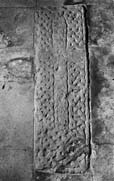Select a site alphabetically from the choices shown in the box below. Alternatively, browse sculptural examples using the Forward/Back buttons.
Chapters for this volume, along with copies of original in-text images, are available here.
Object type: Grave-cover
Measurements: L. 149 cm (58.7 in) W. 44 > 40 cm (17.3 > 15.7 in) D. Built in
Stone type: Greyish yellow oolite grainstone, with ooliths of 0.3 to 0.4mm diameter and some 1mm pellets. Ancaster Freestone, Upper Lincolnshire Limestone, Inferior Oolite Group
Plate numbers in printed volume: Ill. 170
Corpus volume reference: Vol 5 p. 165-166
(There may be more views or larger images available for this item. Click on the thumbnail image to view.)
A complete flat, slightly tapered grave-cover decorated on the upper surface with a cross surrounded by interlace in low relief. Only one face is visible.
A (broad): The boundary of the cover is marked by a roll moulding but it is not known whether the other sides are decorated. Within the border, a cross with plain rectangular arms (type A1) is placed centrally. The cross, which is enhanced by a pair of incised lines around its edges, meets the border moulding at the sides but not at the top or base. The central cross is surrounded by five zones of interlace. The U-shaped area around the crosshead is filled with two zones, the interlace to the right extending only up the right-hand side whereas that on the left also extends across the top. The interlace itself, here as on the rest of the stone, is not very accurately executed; the strands are of domed section with little space in the interstices. Both interlace sequences are four-strand plaits – that to the left is enclosed, that to the right has two free ends. Below the cross-arm, the shaft is surrounded by three distinct zones of interlace. At the base the cross stands on a mound of interlace, but it is here that the stone is most abraded and only the interstices are still legible. The remaining pattern suggests that this was originally an enclosed grid. To either side of the cross-shaft are two runs of four-strand plait. That to the right also incorporates simple pattern F loops, but the sculptor's inventiveness outran his skill and one end is left untied behind the trefoil figure at the base of the pattern.
This is one of the more important late grave-covers in the county. It is clearly related to the large group of flat covers, decorated with a centrally placed cross surrounded by interlace, called here the Fenland group (Chapter V and Table 5). The majority of the members of this group lie outside the county though there are a few examples of the group in Lincolnshire (Whaplode 1 and 3, Market Deeping 2 and Lincoln Cathedral 1, for example). They are easily grouped together not just because of their very similar decorative schemes but also by their highly distinctive shelly stone type, which has been identified as being from the Barnack/Clipsham group of quarries. Although the Ewerby cover shares some similarities of design with members of this group, it is distinguished from them by its more intricate design and by the relative complexity of its interlace pattern. The stone type at Ewerby also separates it from the Fenland group. It is made of a stone similar to that from the Ancaster quarries (approximately six miles west) and should be viewed alongside other monuments indirectly related to the Fenland covers from this source (Lincoln St Mark 8 and 18, and Syston 3) which are related by their layout both to Ewerby and to the dominant products of Barnack/Clipsham. The implication of the Ewerby cover (and of the Lincoln examples) is that the Ancaster quarries were producing derivatives of the Fenland cover type in the years leading up to the Conquest.
The Ewerby cover may be somewhat earlier in date than most of the examples in the group from the Barnack area, as it has only a very slight taper and a much more intricate interlace technique. Furthermore it is possible that the trident Calvary mound form, characteristic of several examples in the Fenland group, may be a debased or stylised version of Calvary mounds composed of, or decorated with, interlace – like that at Ewerby. On these grounds it is possible to suggest that the Ewerby cover may be a transitional monument between the earlier (mid-Kesteven) cover types from the Ancaster quarries and the large, later, Fenlan group, probably from Barnack/Clipsham. Ewerby should consequently be placed between the two groups in date, i.e. at the end of the tenth century or the start of the eleventh.



